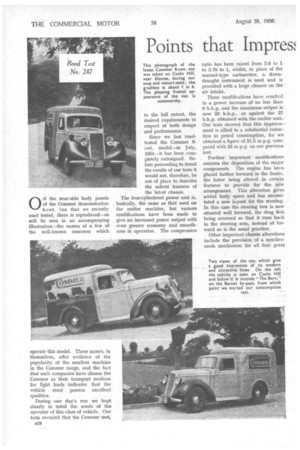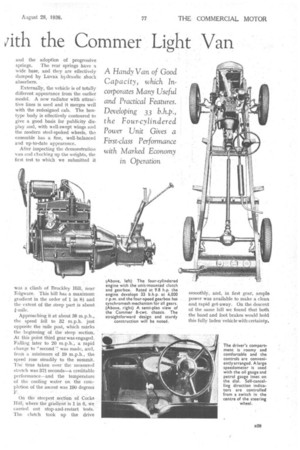Points that Impres; Ath the Commer Light Van
Page 38

Page 39

Page 40

Page 41

If you've noticed an error in this article please click here to report it so we can fix it.
0 el the near-side body panels of the Commer demonstration 8-cwt. van that we recently road tested, there is reproduced—as will be seen in an accompanying illustration—the names of a few of the well-known concerns which
operate this model. These names, in themselves, offer evidence of the popularity of the smallest machine in the Commer range, and the fact that such companies have chosen the Commer as their transport medium for light loads indicates that the vehicle must possess excellent qualities.
During .our, day's run we kept. clearly in mind the needs of the operator of this class of vehicle. Our tests revealed that the Commer met, 628
to the full extent, the desired requirements in respect of both design and performance.
Since we last road tested the Commer 8cwt. model—in July, 1934----it has been completely redesigned. Before proceeding to detail the results of our tests it would not, therefore, be out of place to describe the salient features of the latest chassis.
The four-cylindered power unit is, basically, the same as that used on the earlier machine, but various modifications have been made to give an increased power output with even greater economy and smoothness in operation. The compression
ratio has been raised from 5.6 to 1 to 5.78 to 1, whilst, in place of the normal-type carburetter, a downdraught instrument is used and is provided with a large cleaner on the air intake.
These modifications have resulted in a power increase of no less than 6 b.h.p. and the maximum output is now 33 b.h.p., as against the 27 b.h.p. obtained with the earlier unit Our tests showed that this improvement is allied to a substantial reduction in petrol consumption, for we obtained a figure of 31.5 m.p.g. compared with 28 m.p.g. on our previous test.
Further important modifications concern the disposition of the major components. The engine has been placed farther forward in the frame, the latter being altered in certain features to provide for the new arrangement. This alteration gives added body space and has necessitated a new layout for the steering. In this case the steering box is now situated well forward, the drag link being reversed so that it runs back to the steering arm, instead of forward as is the usual practice.
Other important chassis alterations include the provision of a synchromesh mechanism for all four gears and the adoption of progressive springs. The rear springs have a wide base, and they are effectively damped by Luvax hydraulic shock absorbers.
Externally, the vehicle is of totally different appearance from the earlier model. A new radiator with attrac:tive lines is used and it merges well with the redesigned cab. The boxtype body is effectively contoured to give a good basis for publicity display and, with well-swept wings and the modern steel-spoked wheels, the ensemble has a fine, well-balanced and up-to-date appearance.
After inspecting the demonstration van and checking up the weights, the first test to which we submitted it
was a climb of 13rockley Hill, near Edgware. This hill has a maximum gradient in the order of 1 in 8:1_, and the extent of the steep part is about i-mile.
Approaching it at about 38 m.p.h., the speed fell to 32 m.p.h. just opposite the mile post, which marks the beginning of the steep section. At this point third gear was engaged. Falling later to 20 m.p.h., a rapid change to " second " was made, and, from a minimum of 19 m.p.h., the speed rose steadily to the summit. The time taken over the measured stretch was 371 seconds—a creditable performance—and the temperature of the cooling water on the completion of the ascent was 190 degrees F.
On the steepest section of Cocks Hill, where the gradient is 1 in 6, we carried out stop-and-restart tests. The clutch took up the drive
smoothly, and, in first gear, ample power was available to make a clean and rapid get-away. On the descent of the same hill we found that both the hand and foot brakes would hold this fully laden vehicle with certainty. The results of our hill-climbing tests showed the advantage of having a choice of four close gear ratios and, by making full use of the gears, an excellent performance could be put up. The synchromesh mechanism for all four gears enabled rapid changes to be made with the utmost ease, and this feature should make a strong appeal where the vehicle is to be handled by young and comparatively inexperienced drivers.
Ease of control in every respect ls a marked feature of this Commer
model, and, with a turning circle of approximately 37 ft. in either direction, the vehicle has excellent manceuvrability.
Speeds in the neighbourhood of 50 m.p.h. to 55 m.p.h. are not normally required, but our acceleration tests showed the maximum speed to be approaching 60 m.p.h. The ready attainment of such a speed is, however, an indication of the handiness of the machine in the matter of acceleration, which is, of course, of great importance in effecting rapid deliveries in thickly populated areas.
A graph showing the results of our acceleration tests accompanies this
article, and the curves point to the advisability of frequent use of the silent third gear. The easy gear change makes the use of this ratio a matter of great simplicity and by its full use the performance can be
enhanced to a marked degree. Since the power unit is of the high-speed type full use can be made of all the gears, the ratios of which are, we think, well chosen for the characteristics of the power unit and the load carried.
Of the self-energizing type, the brakes are cable operated. They differ but little in design from those provided on the earlier model, boils pedal and hand lever being connected to the shoes on all four wheels.
Whichever control is used, the retardation, as can be seen from the accompanying graph, is of a high order. The hand brake is little inferior to the foot brake and the latter has an efficiency of rather over 60 per cent. This is a high figure for a commercial vehicle and it is noteworthy that the retardation is markedly smcoth.
For our consumption test we started from "The Barn" on the Barnet By-pass, and, since we expected a return in the region of 30 m. p .h . , we trav elled a distance of 15 miles up the Great North Road to a point a little beyond Welwyn, returning by the same route.
Actually the gallon of petrol that was carefully measured into the test tank took us 14. mile farther than our starting point on the return journey, so that, as previously mentioned, ou r test showed the creditable consumption figure of 31.5 m.p.g.
Two stops were made in each mile to simulate delivery conditions and the average speed, including all stops, was 22.2 m.p.h.
Several hills have to be climbed on the route we took for our consumption test, and the performance of the Commer on the short steep ascent, going southwards out of Welwyn village, and on Digswell Hill is worthy of mention. On the former, third gear was required about halfway up, when the speed dropped to about 20 m.p.h. ; from this point the vehicle accelerated to the summit.
On Digswell Hill, although the van was baulked by a lorry, the climb was easily completed in top gear, the speed at the top being 25
m.p.h. The significance of these figure's will be appreciated by those who are familiar with these acclivities.
The body is of light but strong construction and a capacity of 80 cubic ft. is afforded. Although the body dimensions are greater than on the previous model, there is ample room in the driving compartment.
The driver's seat is very comfortable and the controls are conveniently arranged. A feature of the instrument panel is the large speedometer, on the face of which are incorporated the petrol gauge, oil gauge and ignition warning light. The speedometer is clearly marked with a red line on the 30 tn.p.h. figure and rheostatic illumination of the instrument board enables the lighting to be controlled at night.
The headlamp dipper switch is conveniently arranged in the centre of the steering wheel and self-cancelling direction indicators are a useful item of equipment.
At the price of £146 for the complete van we formed the opinion that the machine represents excellent value for money. Its appearance is modern, the performance is firstclass, and the vehicle should, we think, constitute a valuable asset to any business calling for the use of a light and speedy van.




















































































